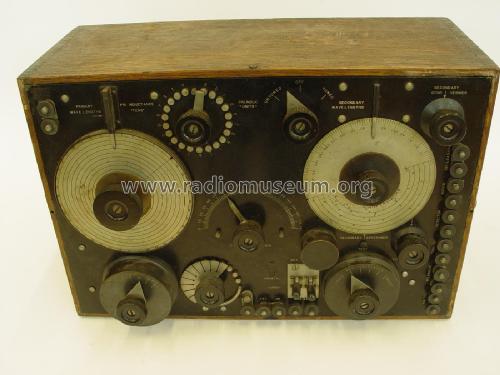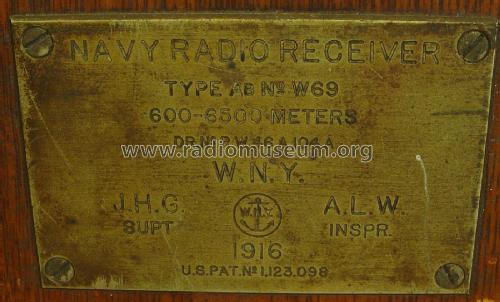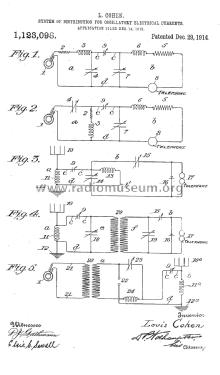Navy Radio Receiver Type AB
MILITARY U.S. (different makers for same model)
- Land
- USA
- Hersteller / Marke
- MILITARY U.S. (different makers for same model)
- Jahr
- 1916
- Kategorie
- Militär-Empfänger
- Radiomuseum.org ID
- 285444
- Hauptprinzip
- Tuner vor 1926 (kein Sperrkreis)
- Wellenbereiche
- Langwellenempfänger und/oder Längstwellen-Empfänger.
- Betriebsart / Volt
- Keine Stromversorgung
- Lautsprecher
- - - Kein Ausgang für Schallwiedergabe.
- Material
- Gerät mit Holzgehäuse
- von Radiomuseum.org
- Modell: Navy Radio Receiver Type AB - MILITARY U.S. different makers
- Form
- Tischgerät, Truhenform, meist mit Deckel (NICHT Schrägpult).
- Abmessungen (BHT)
- 480 x 330 x 280 mm / 18.9 x 13 x 11 inch
- Bemerkung
-
Récepteur pour la marine. gamme d'onde 600 à 6500 m.
1916 Navy Radio Receiver One of the first Navy designed and built receivers.
The W.N.Y. marking means it was made by the Washington Navy Yard. The original 1915 W.N.Y. Types A, B, and C were designed by Dr. Louis Cohen and George Clark (the Navy’s first “Radio Aide”), who was in charge of the “Radio Test Shop” at the Washington Navy Yard at that time. I’ve seen AB and BA sets made by the WNY and believe they are just variants of the early 1915 “Cohen” A, B, C sets.
The Washington Navy Yard, responsible for design of receiving equipment, established a radio laboratory in the River Radio station, which had not been used since the establishment of the station at Radio (Arlington), Va. There, Cohen, assisted by Clark and L. G. Butte, took the best portions of the new developments and incorporated them in the designs of the Navy types "A" (60-600 kc.), "B" (30-300 kc.), and "C" (1,200-3,000 kc.) receivers. These were completed in early 1915 and placed in production at the Washington Navy Yard in the same year.
The Cohen method was used. This consisted of coupling and a modified type of feedback circuit, with a coil in the plate circuit for the purpose of making the vacuum tube oscillate. To avoid the use of the term "feed-back," Clark termed it "a 'tickler' because it tickles the audion and makes it quiver."15 The leads were of solid wire capable of withstanding shipboard vibration and the shock of gunfire. The induction coils were of low resistance as compared with those used in commercial receivers and their values in the two circuits could be varied to provide sharp tuning. Dials were fixed to the shafts of the tuning condensers making it possible to calibrate each receiver so that the operator could tell where to align it for specific frequencies. Arrangements were incorporated to permit the use of either crystal or vacuum tube detection.
- Nettogewicht
- 16.5 kg / 36 lb 5.5 oz (36.344 lb)
- Autor
- Modellseite von Musée des Radios Museum angelegt. Siehe bei "Änderungsvorschlag" für weitere Mitarbeit.
- Weitere Modelle
-
Hier finden Sie 393 Modelle, davon 345 mit Bildern und 210 mit Schaltbildern.
Alle gelisteten Radios usw. von MILITARY U.S. (different makers for same model)
Sammlungen
Das Modell Navy Radio Receiver befindet sich in den Sammlungen folgender Mitglieder.


